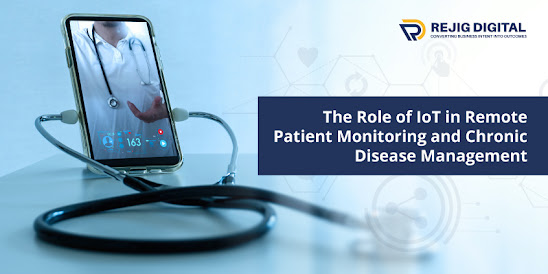The Role of IoT in Remote Patient Monitoring and Chronic Disease Management
Introduction of IoT
An Internet-connected network of physical objects (IoT) that transmit and receive data is the Internet of Things (IoT). The IoT uses sensors and actuators to collect data from these objects, which can then be analysed in real time by computers and other devices. IoT modernises various industries such as IoT in healthcare industry.
The most common example of an IoT device is a smartphone; it's able to connect with other phones via Wi-Fi or cellular networks, so that you can use apps like Facebook Messenger or Google Maps while out in public places like shopping malls or libraries.
Other examples include smart thermostats that adjust room temperatures based on your preferences; fitness trackers that monitor how much exercise you're getting each day; smart appliances such as refrigerators that order groceries when they run low on food items; home security systems equipped with motion detectors for detecting break-ins at night...the list goes on!
IoT in Healthcare Industry: Chronic Disease Management
Chronic diseases are long-term health conditions that require ongoing management and care. Examples of chronic diseases include diabetes, heart disease, and hypertension. These diseases can be debilitating and expensive to manage, both for patients and healthcare providers or caregivers.
However, with the help of leading technologies such as the Internet of Things (IoT) that has the potential to revolutionise the management of chronic diseases by providing remote monitoring and real-time data analysis.
In this article, we will explore how IoTapplicationinhealthcare can play a role in managing chronic diseases and making the process easier for both doctors and patients to watch-out health status throughout disease lifespan..jpg)
Remote Patient Monitoring
One way to provide healthcare outside of the typical clinic environment is through remote patient monitoring (RPM). Patients with chronic conditions might utilise RPM to continuously check their health. RPM devices can be used to track medication adherence as well as to measure vital indicators including blood pressure, blood glucose levels, and heart rate. RPM data may be sent to healthcare professionals for analysis, enabling them to keep track of patients' health state and take appropriate action as needed.
Wearable Devices
Wearable devices have gained significant popularity as a form of IoT technology in healthcare, offering a range of benefits in chronic disease management. One of the major benefits provided by wearable devices is the ability to provide real-time data to healthcare providers. With continuous monitoring of vital signs such as heart rate, blood pressure, and blood glucose levels, wearable devices offer real-time insights into patients' health status. This allows healthcare providers to remotely track patients' condition and intervene proactively when necessary, preventing complications and optimising care
Smart Home Devices
Smart home devices, such as smart thermostats and smart lighting, can be used to improve the management of chronic diseases. For example, smart thermostats can be used to regulate temperature, which is important for patients with certain chronic diseases, such as asthma. Smart lighting can be used to regulate sleep patterns, which is important for patients with chronic sleep disorders.
Real-Time Data Analysis
IoT technology can provide real-time data analysis, which is important for the management of chronic diseases. Real-time data analysis can be used to monitor patients' health status and to identify trends and patterns in their health data. Healthcare providers can use this information to adjust treatment plans and to intervene when necessary.
Improved Patient Engagement
IoT technology can improve patient engagement & experience in the management of chronic diseases in many ways then we ever think about. Patients can use IoT devices to monitor their health status and to track their progress over time. This can motivate patients to take an active role in their own care and to make lifestyle changes that can improve their health.
Challenges of IoT in Chronic Disease Management:
Despite the promising benefits, the integration of IoT into chronic disease management also presents challenges, including:
Data Security and Privacy:
The vast amount of data generated by IoT devices, including sensitive health information, raises concerns about data security and privacy. Healthcare organisations must implement robust security measures to protect patient data from unauthorised access, breaches, and misuse.
Interoperability:
IoT devices come from various manufacturers and may use different communication protocols, making interoperability a challenge. Integration of data from different devices and systems requires standardised protocols and seamless data exchange, which may require significant investments in technology infrastructure.
Regulation and Compliance:
The use of IoT in healthcare is subject to stringent regulatory requirements, including data protection laws, patient consent, and compliance with industry standards. Healthcare organisations must ensure that their IoT solutions comply with regulatory guidelines to avoid legal and ethical issues.
Concluding Lines on IoT in Healthcare Industry to Manage Chronic Diseases
The Internet of Things (IoT) has the potential to revolutionise the management of chronic diseases. IoT technology can be used for remote patient monitoring, wearable devices, smart home devices, real-time data analysis, and improved patient engagement. Healthcare practitioners can monitor patients' health states in real-time using Healthcare IoT Solutions
and take appropriate action as needed. Patients can actively participate in their own care and alter their lifestyles to better their health. IoT technology has the potential to lower healthcare expenditures and enhance the treatment of chronic illnesses.



Comments
Post a Comment